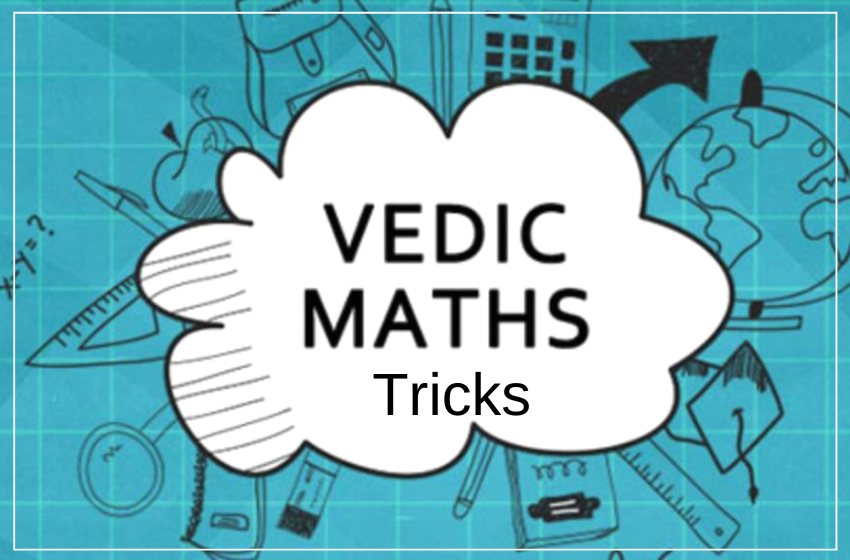Vedic Maths has gained a lot of popularity in some of the last years because of its fast and accurate calculations. Calculation is a crucial part of every profession nowadays, and people with fast calculation abilities seems to have special skill, as not everybody has this ability to calculate fast and accurate. Everybody wants to have this skill as it makes people look smarter.
Vedic maths as the name suggests is based on the knowledge gained from our Vedas but not everybody was able to gain the knowledge that has been given our prestigious Vedas as the ancient language is not everybody’s cup of tea. So to make it more simple for common people Swami Bharti Krishna Tirtha Ji Maharaj, who is the Shankaracharya of Govardhan Peeth, Puri, has given six sutras over which Vedic maths has been set up and it becomes simple for common people to understand it without putting endless efforts.
Now when we say that the information has been taken from Vedas, the question here is which Veda? The answer is “the Atharvaveda”.
Atharvaveda is said to have extreme knowledge of science and mathematics which people are discovering today, but it has been in our Vedas since ancient time. So the Swami Bharti Ji has decoded the information for all of us, compressed it into 16 sutras and presented it for us.
16 Principles (Sutras) of Vedic Mathematic and Sub-Sutra
The main sutras and sub-sutra of Vedic maths are:
| Name / Sutra | Corollary / Sub-Sutra | Meaning |
| Ekadhikena Purvena (एकाधिकेन पूर्वेण) | Anurupyena | By one more than the previous one. |
| Nikhilam Navatashcaraman Dashatah (निखिलं नवतश्मचरमं दशतः) | Sisyata Sesasamjnah | All from 9The last from 10 |
| Urdhava – Tiryagbyham (ऊर्ध्वतिर्यग्भ्याम्) | Adyamadyenantyamantyena | Vertically and crosswise. |
| Paravartaya Yojayet (परावर्त्य योजयेत्) | Kevailash Saptakam Gunyat | Transpose and adjust. |
| Shunyam Saamyasamuccaye (शून्यं साम्यसमुच्चये) | Vestanam | When the sum is the same that sum is zero. |
| Anurupye Shunyamanyat (आनुरुप्ये शून्यमन्यत्) | Shunuya Anayat | If one is the ratio, the other is zero. |
| Sankalana- Vyavakalanabhyam (संकलन व्यवकलनाभ्यां) | Yavadunam Tavadunikritiya Varga Yojayet | By addition and subtraction. |
| Purana Puranabyham (पूरणापूरणाभ्यां) | Antyayordashakepi | By the completion. |
| Chalana – Kalanabyham (चलनकलनाभ्याम्) | Antyayoreva | Similarities and differences. |
| Yavadunam (यावदूनम्) | Samuccayagunitah | The extent of its deficiency. |
| Vyashtisamasthi (व्यष्टिसमष्टिः) | Lopanasthapanabhyam | Part and whole. |
| Shesanyankena Charamena (शेषाण्यङ्केन चरमेण) | Vilokanam | Remainder by the last digit. |
| Sopaantyadyamantyam (सोपान्त्यद्वयमन्त्यम्) | Gunitasamuccayah | The ultimate and penultimate. |
| Ekanyunena Purvena (एकन्यूनेन पूर्वेण) | Dhyajanka | By one less than the previous one. |
| Gunitasamuchyah (गुणितसमुच्चयः) | Dwandwa Yoga | The product of some is equal to the sum of the product. |
| Gunakasamuchyah (गुणकसमुच्चयः) | Adyam Antyam Madhyam | The factors of the sum is equal to the sum of the factors. |
Example of Vedic Maths Sutras
Below are the 16 Vedic Maths Sutras example:
Sutra 1: Ekadhikina Purvena
(One is more than the previous one)
This Sutra is very useful and helps in finding the products of the numbers, if the unit digit’s sum of the two numbers totals to 10.
For example;
24 x 26 =?
= (first digit x one more than first digit) (product of unit digits of both the number)
= ( 2 x 3 ) ( 4 x 6)
= 624
So, 24 x 26 = 624.
You see the answer above has come without doing any elaborate calculation.
Sutra 2: Nikhilam Navatashcaramam Dashatah
(All from 9 last from 10)
This Sutra is commonly used to subtract the numbers from the power of 10.
For example;
10000 – 7688 = 2312
Now if we analyse this situation, the last number is 8 and it is subtracted from 10 and the next 8 is subtracted from 9, whereas all other numbers are subtracted by 9 and the result comes out almost orally.
Sutra 3: Urdhva-Tiryagbyham
(Vertically and crosswise)
This sutra is used For multiplication.
Formula used for this sutra is ab × cd =(ac) (ad + bc) (bd)
The example is given below:
24 x 12
= (2 x 1) (2 x 2 + 4 x 1) (4 x 2 )
= 288
And the answer is 288.
You can see how simple multiplication can become using this sutra.
Sutra 4: Parvaartya Yojayet
(Transpose and adjust)
This sutra is used for division, when the divisor is greater than the power nearest to 10.
Let us see an example using 434\12
The very first thing that we need to see is that the number 12 which is divisor is greater than 10, in that case this sutra can be applied easily. Next we need to check is that how many digits are there in a divisor, this one has two digits so the dividend needs to split into two, 43 and 4, other process is given below;
As shown above, the divisor is written and leaving 1 apart, 2 is taken down as 2 bar, i.e. vinculum 2. The dividend is divided into two parts 43 and 4. 4 of 43 is taken down and to this four, the vinculum 2 is multiplied to get vinculum 8 which is written under 3 of 43. 3 vinculum 8 would be vinculum 5 which is taken down. Vinculum 2 of the divisor is multiplied with this vinculum 5 and the result 10 is written under 4 and totalled to 14.
14 is taken down as it is. Now 45 is a vinculum number because 5 is vinculum. According to Vedic maths rules vinculum, 5 is complemented with 10 to get normal 5 which is taken down. The number next to the vinculum number should be reduced by 1. So, 4 becomes 3 and comes down
And the answer is quotient =35 and remainder = 14 when 434/12.
Sutra 5: Shunyam Saamyasamuuaye
(When the sum is the same the sum is zero)
This sutra is used to solve equations in the forms given below:
ax + b = cx + d
So, x = d – b/a – c
(x+a)(x+b) =(x+c)(x+d)
So, x = cd-ab/a+b-c-d
Some applications
A term which occurs as a common factor in all the terms is equated to zero e.g. : 14x + 9x = 4x + 12x. Here x occurs as a common factor with all terms and hence the value of x according to this sutra is zero.
If the product of the independent term on either side of the equation is equal the value of the variable will be zero, which is the second interpretation of this sutra.
E.g.
(x +8) (x+3) = (x + 12 ) (x + 2 )
8 x 3 = 24 = 12 x 2 and hence value of x in this equation would be 0
Sutra 6 : Anurupyena-Sunyamanyat
(If one is in ratio, the other is zero)
This sutra is also used to solve equations.
Suppose:
2x + 4y = 8
And
4x + 6y = 16,
The ratio of terms with x = 2x/4x = ½
The ratio of the R.H.S term is also 8/16 = ½
Therefore, the other variable, in this case y = 0
Substituting this value of y in any other of the two equations, we can get value of x
2x + 4(0)=8
2x = 8
Therefore x= 8/4 = 2.
Sutra 7: Sankalana-Vayavakalanabyham
(By addition and by subtraction)
This sutra is used to solve equations but with a condition and the condition is that if the coefficient of 1 variable is same in both the equations, irrespective of the signs being used.
Wait, no need to get confused, what it means is that the coefficient of 1 variable in 1st equation should be equal to the 2 variable in 2nd equation and in the same way the coefficient of 2nd variable in first equation should be equal to the 1st variable in second equation. If the condition matches, the equations can be easily added and subtracted.
For example;
4x + 2y = 6………… equation 1 and
2x + 4y = 7 ………….equation 2.
Now add equation 1 and 2 we get
6x + 6y = 13 or
6 (x + y) = 13 or
X + y = 13/7…………we get equation 3.
Subtract equation 2 for equation 1
2x -2y = -1
2 (x -y ) = -1 or
X – y = – 1 / 2 …… we get equation 4…….therefore
Y = x + 1 / 2…………equation 5 substitute this in equation 3.
So we get
X + (x + ½) = 13/7… solving for x, we get
X = 19/7 = 2.71…….
And y = x + 0.5….. from equation 5
So, y = 2.71 +0.5= 3.21
Sutra 8: Purana Purana Byham
(By the completion or non-completion)
This sutra can be used to solve problems of addition but with a condition, which is; when the unit digits of the numbers add up to 10.
For example;
Numbers 22 and 18 the unit digits add up to 10.
Let try to add 295 + 46 + 28 + 15 + 44 + 22 =?
Now we need to check and number and pair them in such a way that their unit places add up to 10. So….
295 + 46 + 28 + 15 + 44 + 22 =?
Rearrange to put the paired number together.
(295 + 15) + (46 + 44) + (28 + 22)
300 + 90 + 50 = 440.
This happened in easy steps instead of long calculations.
Sutra 9: Chalana kalanabyham
(difference and similarities)
The application of this sutra can be found in calculus to find roots of a quadratic equation and the another application is in differential calculus for factorizing 3rd, 4th, and 5th degrees expression. This sutra finds very specialized applications in the area of higher mathematics.
Sutra 10: Yavadunam
(Whatever the extent of its deficiency)
This sutra is used to find squares of numbers that are close to the powers of base 10.
You need to compare the number with the closed base to the number and find the deficiency or excess. After which you need to square the difference of numbers and this is one part of the answer after which you reduce the given number or increase the same by the difference the number has to the power of base 10.
Let us understand this with an example;
Let us try to find the square of 12
12 is near to 10 and it is 2 excess than 10.
- Square the difference (excess in this case). So 2 x2 = 4….this is the unit place
- Now add the excess to the number. The number is 12 so 12 + 2 = 14…this is the left part of the answer
- Combining both of them we get = 144
- Solving it in equation form
- 122 = (12 + 2) ( 2)2 = 144
Sutra 11: Vyashtisamanstih
(Part and whole)
This sutra helps in the factorization of quadratic equations.
Sutra 12: Shesanyankena charamena
(The remainders by the last digit)
This sutra gives you the process of converting fractions to decimals.
For example; 1/29
- The last digit of the divisor should be 9. It is in this case, now increase the value by 1 of the number next to 9. So, the number is 2 and increasing it by 1 makes it 3
- The dividend is 1 now it has to be divided by 3 so,
- 1 / 3
- Doing it mentally it will be 0.0 and remainder 1 and it is written as
- 0.10 and 10 is divided by 3 and it will be written as 3 and remainder 1 written to left
- 0.1 01 3 now 13 is to be divided by 3 and it will be written as 4 and remainder 1 written to left
- 0.101314 and keep on dividing it by 3 to as many decimal places as needed. For three decimal places the answer is 0.034
Sutra 13: Sopaantyadvayamantyam
(The ultimate and twice the penultimate.)
This sutra is used to find solution of equations in the following form
1/ ab + 1/ac = 1/ad + 1/bc
Where a, b, c and d are in arithmetic progression
B= a + z
C = a + 2z
D = a + 3z
Solution for such equations is 2c + d = 0
1. g.
1/ (x+1)(x+2) + 1/ (x +1)(x+3) = 1/ (x+1)(x + 4) + 1/ (x+2)(x +3)
Now according to the above sutra the solution would be
2(x +3) + (x+4) = 0
2x + 6 + x + 4 = 0
3x + 10 = 0
X = -10/3
Sutra 14: Ekanyunena Purvena
(By one less than the previous.)
Multiplication problems can be solved using this sutra.
The product of two number can be calculated using this sutra when the multiplier consists of only 9
For example;
12 x 99 = ?
The process to do it is
- Reduce 1 from multiplicand i.e. 12-1=11
- The other part of the answer would be 99-11 = 88 (complement of 99)
Hence the answer is 1188
Sutra 15: Gunita Samuchaya
(The product of the sum is equal to the sum of the product)
This sutra is useful to find the correctness and accuracy of the answers in factorization problems and it states that the sum of the coefficients in the product is equal to the sum of coefficients of the factors and if this condition is satisfied then the equation can be considered to be balanced.
For example;
let us consider a quadratic equation
8×2 + 11x + 3 = (x+1)(8x+3)
In this case, the sum of coefficients is 8+11+3=22
Product of the sum of coefficients of the factors =2 (8+3)= 2 x 11 = 22
Since both, the totals tally the equation is balanced and correct.
Sutra 16: Gunakasamuchya
(The factor of the sum is equal to the sum of the factors.)
This sutra holds good for a perfect number.
Let us find the factors of number 28,
1 x 28= 28
2 x 14 = 28
4 x 7 = 28
So, in this case, the sum of factors is 1+2+4+7+14 = 28
The sum of factors equals the factor of the sums, so 28 is said to be a perfect number.
Frequently Asked Questions
Q1. How is Vedic Mathematics useful?
Ans. Vedic mathematics helps in making one’s calculation more accurate and also helps in speeding up one’s calculation abilities. Having this skill in oneself can automatically boost up the confidence and one do not have to run from the situations where there is any kind of calculation required.
Q2. Is Vedic Mathematics a part of our education curriculum?
Ans. Vedic Mathematics is not officially included in our education curriculum, but students opt Vedic m mathematics to prepare for certain competitive exams like SSC, RRB, UPSC, IBPS, etc. Because during these examinations students need to have fast calculation skills as there is a limited time for competitive exams and questions are more.





